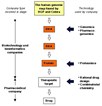The Human Genome Map - Starting Point Of A Long And Profitable Journey

Datamonitor analysis points to opportunities in genome mapping
Table of Contents
Opportunities in Analyzing Raw Genetic Data
Early Investments, Competitive Edge
On June 26, 2000, the publicly funded Human Genome Project (HGP) and the private company Celera Genomics announced that they had completed their first drafts of the human genome. While Celera has sequenced 99% of the genome through its "shotgun" technique, HGP has accurately deciphered 85% of the human genome and expects to produce a 99.99% accurate map by 2003.
This milestone scientific advance opens the way for understanding the root of many diseases and for potentially finding highly tailored treatments and prophylactics. In terms of deriving commercial profits from the mapped human genome, however, there is still a long way to go.
For biotechnology and pharmaceutical companies, Datamonitor has identified the following opportunities:
- In the short to medium term, the biggest opportunities are for biotechnology companies to analyze the raw genetic data.
- In the long term, early investment in the human genome could provide pharmaceutical companies with a significant competitive edge.
Opportunities in Analyzing Raw Genetic Data
The raw genetic information found by HGP and Celera forms the basic material from which scientists will gain valuable insights about human characteristics and diseases. However, the raw information itself is of little value to pharmaceutical companies, since they need to understand the function of a gene before a drug can be identified that targets one of the reactions causing disease.
The diagram below illustrates the path of drug discovery, leading from basic genetic information to a therapeutic target and, eventually, a tailored drug.

Figure 1. The path of drug discovery: key enabling technologies using raw genetic data (Datamonitor diagram)
The opportunities in the short to medium term lie in the analysis of the basic genetic data gained from HGP and Celera. Throughout the project, HGP has supplied its information for free on a public database on the Internet. Celera, on the other hand, has not yet offered its information publicly, but has stated that the data will become freely available to academic researchers on the company's website. Moreover, Celera offers an extensive bioinformatics database, where subscribers will have access to both the basic data and Celera's analytical tools. In Celera's press release from June 26, 2000, the company also states that no other database companies will be able to re-distribute its data.
Consequently, biotechnology companies could either use the publicly available HGP data for further genomic analysis or subscribe to Celera's bioinformatics database, in which case royalties will need to be paid on any future revenues deriving from Celera's data. If a biotechnology company discovers the specific function of a gene that is likely to be relevant in a disease, it can then patent its findings and charge licensing fees if other companies use them in their R&D activities. This is also where the long-term opportunities for pharmaceutical companies arise, namely from licensing agreements with biotechnology companies involved in genomics.
Early Investments, Competitive Edge
Since SmithKline Beecham entered into the first extensive licensing agreement with Human Genome Sciences (HGS) in 1993, many of the major pharmaceutical companies have followed suit, including American Home Products, Bayer, Bristol-Myers Squibb, Glaxo Wellcome, Monsanto, Pfizer, Pharmacia & Upjohn, Rhône-Poulenc Rorer, Roche, and Warner-Lambert. Examples of major genomics companies involved in such deals include Affymetrix, Axys, Celera, Genome Therapeutics, HGS, Incyte Genomics, and Millenium.
With the mapping of the whole human genome, the raw material available for research has increased and, therefore, so have the opportunities for making discoveries that could lead to highly profitable drugs in the long term future. Therefore, Datamonitor believes that pharmaceutical companies that enter licensing agreements with genomics companies using data from HGP's and Celera's databases will gain significant competitive advantage in the long term. This advantage will not prove profitable in the near or medium term, but could potentially take the form of a rich R&D pipeline leading to highly effective and profitable treatments in the next decade.
For more information: Elisabeth Overend-Freeman, Datamonitor, 1 Park Ave., 14th Floor, New York, NY 10016. Tel: 212-686-7400, ext. 765. Fax: 212-686-2626.
Edited by Angelo DePalma
Managing Editor, Drug Discovery Online and Pharmaceutical Online
